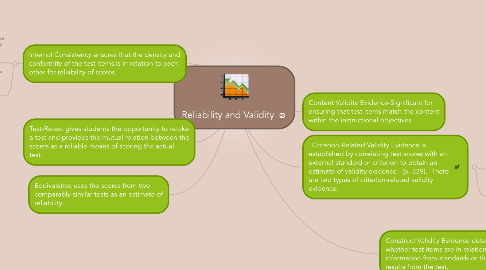Reliability and Validity
by LaTonya Grady

1. Test-Retest gives students the opportunity to retake a test and provides the mutual relation between the scores as a reliable means of scoring the actual test.
2. Equivalence uses the scores from two comparably similar tests as an estimate of reliability.
3. Internal Consistency ensures that the density and conformity of the test items is in relation to each other for reliability of scores.
3.1. Split half methods test reliability by spliting the test in odd/even numbered halves as a way to determine the relational scores between the two.
3.2. Kuder-Richardson method signifies, "The extent to which the the entire test represents a single, fairly consistent measure of a concept" (Kubiszyn and Borich 2010).
4. Content Validity Evidence-Significant for ensuring that test items match the content within the instructional objectives.
5. "Criterion-Related Validity Evidence is established by correlating test scores with an external standard or criterion to obtain an estimate of validity evidence" (p. 339). There are two types of criterion-related validity evidence.
5.1. Concurrent Criterion Relate evidence is significant for using criterion measurements at synchronized times and using these scores to determine validity of the tests.
5.2. Predictive Validity Evidence uses measureable tests at different periods that will eventually determine one's future fate.
6. Construct Validity Evidence determines whether test items are in relation to other information from standards or theories as results from the test.


